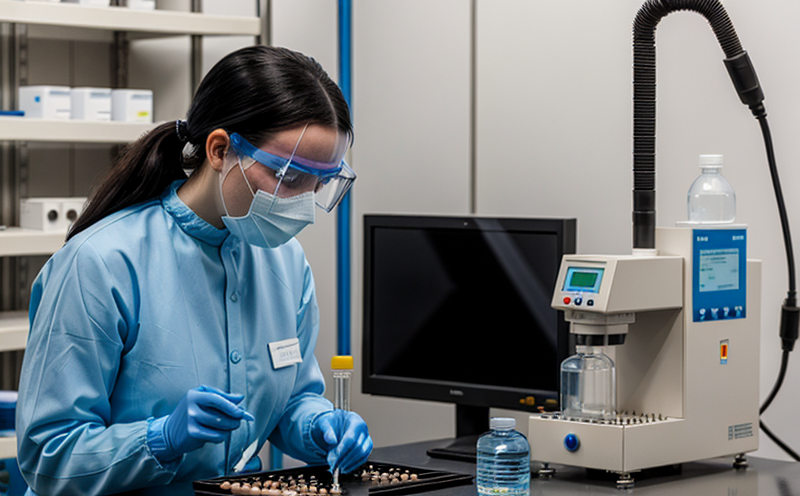Chiral Chromatography Stereoisomer Impurity Testing
In pharmaceutical testing, the importance of ensuring product purity and safety cannot be overstated. Chiral chromatography stereoisomer impurity testing is a critical analytical technique employed to separate and quantify enantiomers in chiral compounds. This process plays an essential role in drug development, manufacturing, and quality assurance by identifying and quantifying the presence of atropisomers or diastereoisomers that may arise due to racemization or other mechanisms.
Chiral chromatography is based on the use of a column packed with a chiral stationary phase. The enantiomers interact differently with this phase, leading to separation even when they are identical in every way except for their three-dimensional structure. This technique finds application primarily in the analysis of drugs that possess an asymmetric carbon atom, as these compounds exist in two forms: the R- and S-enantiomers.
The method is particularly valuable for assessing the purity of APIs (active pharmaceutical ingredients) and ensuring compliance with regulatory standards such as those set forth by the International Conference on Harmonisation (ICH). The ICH Q3A guideline specifically addresses the need to control atropisomers, which are a special type of stereoisomer that result from the rotation about certain bonds.
The testing process begins with sample preparation. Depending on the compound’s properties, extraction methods such as liquid-liquid or solid-phase extraction may be used to isolate the analyte. Post-extraction, the sample is injected into the chiral column, where it undergoes separation based on the interaction between the enantiomers and the stationary phase.
Post-separation, the eluent containing the separated enantiomers passes through a detector capable of measuring the optical activity or absorbance differences. Common detectors include UV/Vis spectrometers, polarimeters, or mass spectrometers, depending on the compound’s characteristics.
The resulting chromatogram provides a visual representation of the separation process, from which key parameters such as retention time, peak area, and tailing factor are extracted. These data points help in quantifying the amount of each enantiomer present in the sample. This information is crucial for determining whether a drug product meets its specified purity requirements.
The accuracy and precision of chiral chromatography make it indispensable in pharmaceutical quality assurance. The technique allows for the detection of trace amounts of impurities that might otherwise go unnoticed with less sensitive methods. This capability ensures that drugs released to the market are safe and efficacious, thereby enhancing public health outcomes.
Moreover, the results from this testing can inform process improvements within manufacturing facilities. By identifying problematic stages in the synthesis or purification processes where enantiomers may be lost or contaminated, pharmaceutical companies can take proactive measures to enhance their production methods.
In summary, chiral chromatography stereoisomer impurity testing is a powerful tool that contributes significantly to the overall quality control efforts within the pharmaceutical industry. Its ability to detect and quantify subtle differences in molecular structure ensures that only high-quality products reach consumers, thereby upholding the integrity of drug development and manufacturing processes.
- Key Benefits:
- Precise quantification of enantiomers
- Identification of atropisomers and diastereoisomers
- Compliance with ICH Q3A guidelines
- Enhanced public health outcomes through improved drug purity
Applied Standards
The implementation of chiral chromatography for stereoisomer impurity profiling adheres to several international standards and guidelines. These include the International Conference on Harmonisation (ICH) Q3A guideline, which specifically addresses the control of atropisomers in pharmaceuticals. Additionally, the European Pharmacopoeia and United States Pharmacopeia also provide specifications that support the use of this technique.
The ICH Q3A guideline emphasizes the importance of ensuring that drugs are free from enantiomeric impurities that could potentially alter their efficacy or safety profile. This standard sets forth criteria for the selection, validation, and application of chiral chromatography methods in pharmaceutical development and manufacturing.
European Pharmacopoeia 2.6.30 provides detailed procedures for the analysis of stereoisomers using HPLC (High-Performance Liquid Chromatography) with a chiral column. It outlines the requirements for both method validation and sample preparation, ensuring that all analytical processes are conducted under controlled conditions.
Similarly, the United States Pharmacopeia offers specific instructions on how to perform chiral chromatographic analyses in accordance with good laboratory practices (GLP). These guidelines ensure that results from these tests are reliable and reproducible across different laboratories.
The application of these standards ensures consistency and accuracy in stereoisomer profiling. By adhering strictly to these protocols, pharmaceutical companies can demonstrate compliance with regulatory requirements and maintain the highest levels of product quality.
Industry Applications
Chiral chromatography stereoisomer impurity testing finds extensive application across various sectors within the pharmaceutical industry. This includes drug discovery, development, manufacturing, and quality assurance.
In drug discovery, chiral chromatography helps researchers identify potential lead compounds with optimal stereoisomeric purity. By ensuring that only pure enantiomers are used in further stages of development, this technique can significantly reduce the likelihood of adverse side effects once a compound reaches clinical trials or is approved for commercial use.
During drug development, chiral chromatography plays a critical role in optimizing synthesis routes and purification methods to minimize the formation of unwanted stereoisomers. This not only improves the efficiency of production processes but also ensures that the final product meets strict purity standards as defined by regulatory bodies like the FDA or EMA.
In manufacturing, chiral chromatography is employed to monitor process conditions throughout large-scale productions. By continuously analyzing samples at various stages of synthesis and purification, manufacturers can quickly identify any deviations from expected outcomes and take corrective actions promptly.
Finally, in quality assurance, chiral chromatography serves as a final check before releasing batches of API into the supply chain. It ensures that all products meet stringent safety and efficacy criteria set by regulatory authorities worldwide. This step is crucial for maintaining trust with healthcare providers and patients who rely on these medications to treat various medical conditions.
The versatility and precision offered by chiral chromatography make it an indispensable tool in modern pharmaceutical laboratories. Its ability to detect even trace amounts of impurities ensures that only high-quality products reach consumers, thereby upholding the integrity of drug development and manufacturing processes.





